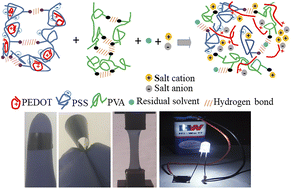Fabrication of highly stretchable salt and solvent blended PEDOT:PSS/PVA free-standing films: non-linear to linear electrical conduction response†
Abstract
Nowadays, ductile and conducting polymeric materials are highly utilizable in the realm of stretchable organic electronics. Here, mechanically ductile and electrically conducting free-standing films are fabricated by blending different solvents such as dimethyl sulfoxide (DMSO), diethylene glycol (DEG) and N,N-dimethylformamide (DMF), and salts such as silver nitrate (AgNO3), zinc chloride (ZnCl2), copper chloride (CuCl2) and indium chloride (InCl3) with the homogeneous solution of poly(3,4-ethylenedioxythiophene):polystyrenesulfonate (PEDOT:PSS) and poly(vinyl alcohol) (PVA) through solution casting method. The presence of salt modifies the PEDOT conformation from benzoid to quinoid, and induces the evolution of different morphologies. ZnCl2 or AgNO3 blended films have lower surface roughness and good miscibility with polymers, while CuCl2 or InCl3 blended films have relatively higher surface roughness as well as irregularly distributed surface morphology. Some crystalline domains are also formed due to the salt agglomeration. The presence of salt inside PEDOT:PSS/PVA/solvent system changes the current–voltage response from non-linear to linear. Among all the films, zinc salt blended PEDOT:PSS/PVA/DMSO, PEDOT:PSS/PVA/DEG and PEDOT:PSS/PVA/DMF films have higher conductivity, and zinc salt blended PEDOT:PSS/PVA/DEG film shows the highest conductivity of 0.041 ± 0.0014 S cm−1, while silver salt blended PEDOT:PSS/PVA/DMSO, PEDOT:PSS/PVA/DEG and PEDOT:PSS/PVA/DMF films have higher elongation at break, and silver salt blended PEDOT:PSS/PVA/DMSO film shows the highest elongation at break of 670 ± 31%. Both the charge carriers, i.e., electrons and ions, contribute to the electrical conduction, and the presence of hydrogen bonds and ionic interactions among PEDOT+, PSS−, PVA, residual solvent, salt cations and anions modifies the film behaviours. Among all the films, ZnCl2 blended PEDOT:PSS/PVA/DMSO film offers relatively superior behaviours having higher conductivity (0.025 ± 0.0013 S cm−1) and elongation at break (517 ± 15%), and therefore can have potential applications in the fields of wearable devices, bioelectronics, etc.



 Please wait while we load your content...
Please wait while we load your content...